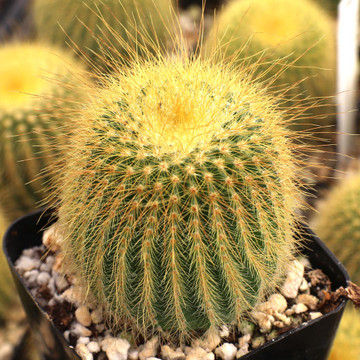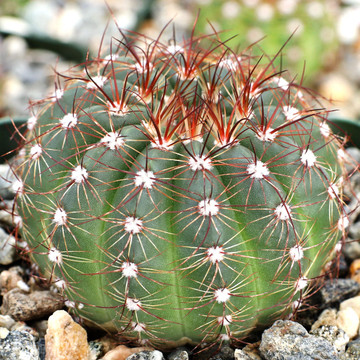Parodia (par-o-di-a) is a rather controversial genus from a taxonomic standpoint. However, cacti that were, and are, included in Parodia are very popular in cultivation and make for very attractive houseplants.
APPEARANCE
- Form: In general Parodia consists of short, globose plants that are either ribbed or tuberculate. Their spines vary in length and thickness.
- Colors: The stems are always green but the spines can be yellow, white, red or black.
- Foliage: All of the foliage is organized into spines. There are no photosynthetic leaves.
- Flowers: These arise from hairy buds on the top of the plant. They typically have warm colored flowers, either yellow, orange or red. The stigma of these flowers can be seen, very clearly, in the center. This is because they tend to be an intense and very contrasting color when compared to the petals.
CARE
- Light: They do their best growing and flowering in full sun conditions.
- Soil: Pick a gritty, well-draining mix like a cactus and succulent soil (available at garden centers) or mix your own (more info).
- Water: Water deeply enough for water to run out the container’s drainage hole. Allow soil to completely dry before watering again. Keep dry in winter.
- Hardiness: Parodia are not frost hardy and should be brought indoors to a sunny window sill if there is a chance of frost. (What’s my zone?)
- Propagation: Some of these plants produce offsets that can be rooted without difficulty. However, others need to be propagated via seed.
NOTES FROM THE NURSERY
These plants are easy to grow and many have truly breath taking flowers. Parodia erubescens is a great example of this. Its flowers are lemon yellow, large and are contrasted nicely by a purple, branched stigma at the center of the flower. It's quite easy to get lost staring down into these flowers!
Despite the taxonomic controversy, we omit the name Notocactus from our product titles but you can see it in many Parodia listings in the product description. As Notocactus is a very old name for a very popular genus, it's certainly understandable that many collectors would have a strong affinity for that name. However, the debate has settled somewhat over the name Parodia so that is the primary name we use to refer to this genus.
READ MORE





